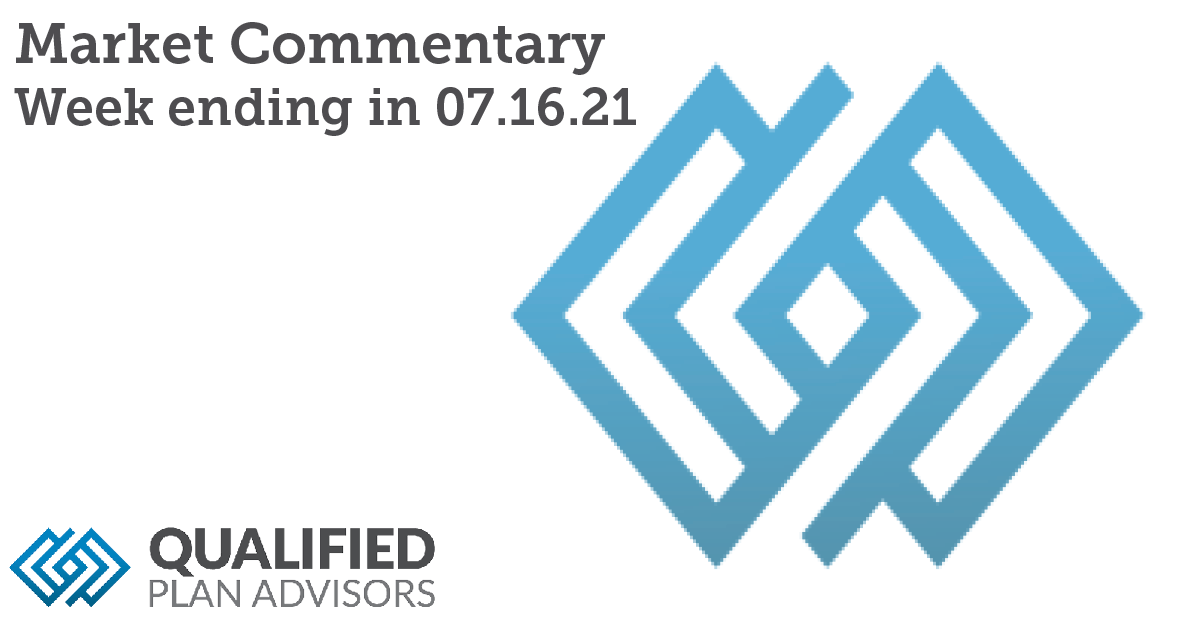The Bottom Line
● U.S. equities, save for the Russell, lost their footing for the week and were in the red. Despite the negative week, the S&P was up for the month of July, the sixth consecutive month in the green.
● The 2- and 10-Year yield both resumed their downward trend, falling -1bps and -5bps respectively .
● The week was heavy with economic data releases, including a miss on GDP, strong consumer income and spending numbers, and the FOMC interest rate decision and Powell’s press conference on the meeting
Duck, Duck, Dove
To no surprise, the FOMC left rates at near 0.0%. What markets have been more interested of late is the language surrounding their decision. Investors are searching for any clues as to when and how the Fed will begin to taper its purchase of assets. The Fed is still looking for “substantial further progress” in the economic recovery, but did admit that progress is occurring. Markets ultimately shrugged off Chairman Powell’s comments on Wednesday and Thursday with most major US and international indices posting a positive return on Thursday. The major indices weren’t able to carry their upward momentum into Friday and all ended the week down, with the exception of the Russell and European equities, both up for the week at +0.75% and+0.05% respectively. The Nasdaq lost the most, posting a -1.11% decline, followed closely by Japanese equities with the Nikkei losing -0.96%, and the S&P lost -0.37% for the week. Yields resumed their decline as well with both the 2-and 10-year Treasury Notes declining by -1bps and -5bps respectively. Despite the downturn on Friday, the S&P has advanced for the past six months in a row and all major US and International indices have posted healthy year to date returns, with the Nikkei being the exception at -0.59%.
Digits & Did You Knows
NEXT MONTH — August has been the 2nd worst performing month for the S&P 500 index over the last 30 years (1999-2020), losing and average of -0.2% (total return) over the period. However, the S&P 500 gained +7.2% (total return) in August 2020. (source: BTN Research)
THE HIGH COST OF CARE — 12% of US retirees, i.e., 1 out of 8, will spend at least 4 years in a nursing home. (source: Bureau of labor Statistics, BTN Research)
CHEAPER NOW — The median 2-bedroom apartment in San Francisco cost $3,146 per month in March 2020, but has dropped 14% to $2,695 per month as of July 2021. (source: www.apartmentlist.com, BTN Research)

Click here to see the full review.
—
Source: Bloomberg. Asset‐class performance is presented by using market returns from an exchange‐traded fund (ETF) proxy that best represents its respective broad asset class. Returns shown are net of fund fees for and do not necessarily represent performance of specific mutual funds and/or exchange‐traded funds recommended by the Prime Capital Investment Advisors. The performance of those funds may be substantially different than the performance of the broad asset classes and to proxy ETFs represented here. U.S. Bonds (iShares Core U.S. Aggregate Bond ETF); High‐YieldBond(iShares iBoxx $ High Yield Corporate Bond ETF); Intl Bonds (SPDR® Bloomberg Barclays International Corporate Bond ETF); Large Growth (iShares Russell 1000 Growth ETF); Large Value (iShares Russell 1000 ValueETF);MidGrowth(iSharesRussell Mid‐CapGrowthETF);MidValue (iSharesRussell Mid‐Cap Value ETF); Small Growth (iShares Russell 2000 Growth ETF); Small Value (iShares Russell 2000 Value ETF); Intl Equity (iShares MSCI EAFE ETF); Emg Markets (iShares MSCI Emerging Markets ETF); and Real Estate (iShares U.S. Real Estate ETF). The return displayed as “Allocation” is a weighted average of the ETF proxies shown as represented by: 30% U.S. Bonds, 5% International Bonds, 5% High Yield Bonds, 10% Large Growth, 10% Large Value, 4% Mid Growth, 4%Mid Value, 2% Small Growth, 2% Small Value, 18% International Stock, 7% Emerging Markets, 3% Real Estate.
Advisory services offered through Prime Capital Investment Advisors, LLC. (“PCIA”), a Registered Investment Adviser. PCIA doing business as Prime Capital Wealth Management (“PCWM”) and Qualified Plan Advisors (“QPA”).
© 2021 Prime Capital Investment Advisors, 6201 College Blvd., 7th Floor, Overland Park, KS 66211.










